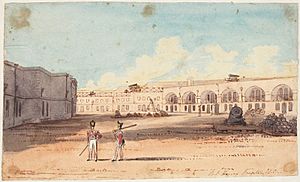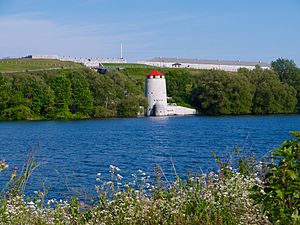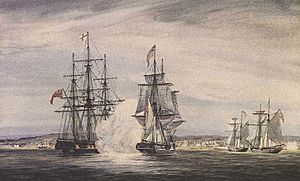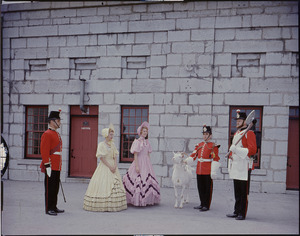Fort Henry National Historic Site facts for kids
Quick facts for kids Fort Henry National Historic Site |
|
|---|---|
 |
|
| Location | Point Henry, Kingston, Ontario, Canada |
| Established | First fort: 1812–1814 Second fort: 1832–1836 |
| Owned by | Government of Canada (Parks Canada), Operated by Ontario Ministry of Heritage, Sport, Tourism and Culture Industries (St Lawrence Parks Commission) |
| Managed by | Kathryn Lowe |
| Designation | National Historic Site of Canada |
| Website | http://www.forthenry.com |
| Designated: | 1936 |
Fort Henry National Historic Site is a famous old fort located in Kingston, Ontario, Canada. It sits on a high piece of land called Point Henry. This spot is very important because it's near where the Cataraqui River meets the St. Lawrence River and Lake Ontario. The fort and the land it's on were named after Henry Hamilton, who was a governor of the Province of Quebec a long time ago.
A fort was first built here during the War of 1812. Its job was to protect the Kingston Royal Naval Dockyard (where ships were built and repaired) from possible attacks by Americans. It also watched over ships moving on the St. Lawrence River and Lake Ontario. Later, in the 1830s, a much bigger fort was built. This new fort continued to protect the naval dockyard and the southern entrance to the Rideau Canal. Today, Fort Henry has been restored and is a popular place for tourists to visit.
Contents
History of Fort Henry
Why the Fort was Built
After the American Revolution, there was still some tension between the British and Americans. Because of this, the British thought Point Henry was a great place to build a fort to defend the area. However, they didn't actually build one until the War of 1812 started.
In 1783, the British military set up a base in what is now Kingston. They used parts of an old French fort called Fort Frontenac. But this location and the growing town were hard to defend. So, Captain John Ross, a British officer, suggested moving the main defense and the town to the safer Point Henry.
In 1794, Lord Dorchester ordered a survey of Point Henry and nearby areas. This was to find the best spot for a navy base. Lieutenant Alexander Bryce of the Royal Engineers thought Haldimand Cove (now Navy Bay) was best for the navy. He also recommended building a fort on Point Henry to protect it.
The First Fort
When the War of 1812 began, local soldiers built a small fort on Point Henry. It had a blockhouse (a small, strong fort) and a battery (where cannons were placed). This was to protect the important naval base on Point Frederick, which was across the water. It also helped them watch ships on the St. Lawrence River and Lake Ontario.
On November 10, 1812, the cannons at Point Henry helped fight off American warships. These ships were attacking the British ship Royal George in Kingston Harbour. This battle showed everyone that a stronger fort was needed. So, in 1813, soldiers started building more batteries and barracks (places for soldiers to live). This fort was one of many defenses built around Kingston during the war.
By 1820, the fort had earth and stone walls, special defensive shapes called demi-bastions and redans, ditches, and places to store gunpowder. It also had barracks, signal towers, and other cannon positions.
The Second Fort

Even after the War of 1812, the British and Americans still didn't fully trust each other. Because of this, the first fort was taken down. A much bigger fort was built between 1832 and 1836. Its main job was to protect the end of the important Rideau Canal on Lake Ontario. It also protected the harbour and the naval dockyard.
In 1843, a part of the fort overlooking the lake was finished. This included stone buildings called casemated commissariat stores and magazines. These buildings connected the outer defenses to the main fort. Even bigger defenses were planned, but they cost too much money. So, only four Martello towers (round defensive towers) and the main fort were built. At that time, these defenses were the strongest in Canada, west of Quebec City. Neither the first nor the second Fort Henry was ever attacked. The fort was sometimes called the "Citadel of Upper Canada" because it was so strong.
British soldiers were stationed at Fort Henry from 1813 to 1870. After that, Canadian soldiers used the fort until 1891. As relations with the United States got better, there was no longer a need for strong defenses along the border. The military left the fort, and it slowly started to fall apart.
Fort Henry also held prisoners at different times. It held prisoners from the 1837–38 Rebellions. During Canada's first national internment operations (1914–1920), German, Austrian, and Turkish prisoners of war were held there. Some civilians, including Ukrainian immigrants, were also held. During the Second World War, the fort was a prisoner-of-war camp for German air force (Luftwaffe) and navy (Kriegsmarine) soldiers.
Fort Henry Today

In the 1930s, Fort Henry was restored as part of a government program during the Great Depression. It became a "living museum" when the Fort Henry Guard was created. The fort officially opened to the public on August 1, 1938.
Today, Fort Henry is managed by Parks Canada and run by the St. Lawrence Parks Commission. People dressed in old military uniforms, called the Fort Henry Guard, show visitors what life was like for British soldiers. They also give tours. The Fort Henry Guard has been around for a long time, since 1938. They help keep the spirit of 1867 alive and protect the fort. The Guard includes not just military roles but also people who show what daily life was like.
You can also take self-guided tours. Other fun activities include historical reenactments of military drills and battle plans. There's also the Garrison Parade, a Victorian School Room, and the Muster Parade. At the Muster Parade, young visitors can dress in old uniforms and learn to march. Every Wednesday in July and August, there's a Sunset Ceremony. This event features historic drills, music, and cannons firing. Some tour companies also offer evening tours that talk about the fort's supposedly haunted past.
Fort Henry is a National Historic Site of Canada. In 2007, it became part of the UNESCO World Heritage Site for the Rideau Canal.
Legacy
On June 30, 1983, Canada Post released a stamp called 'Fort Henry, Ont.' It was part of the "Forts Across Canada Series."
See also
- Fort Frederick
- List of forts




